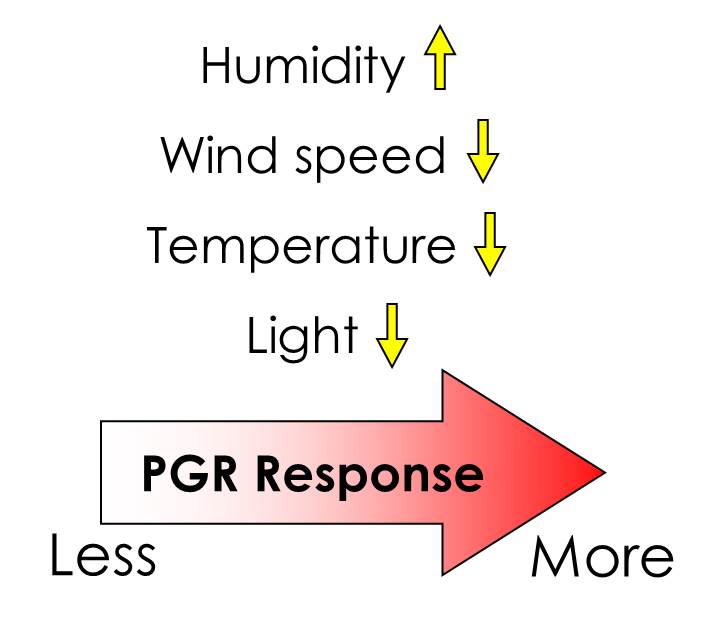
Environment and PGR Interactions
Plant growth regulators (PGRs) are used throughout the floriculture production chain to inhibit or promote extension growth, inhibit or stimulate lowering, promote rooting or branching or inhibit flower senescence. Some are applied as cutting or liner dips, others as substrate drenches, but most are applied as foliar sprays. When PGRs are applied as sprays, their efficacy can be greatly influenced by the environment. Understanding how environmental factors influence PGR spray efficacy can lead to more effective and predictable plant responses.
The efficacy — and consistency — of PGR applications to a crop primarily depend on the growth stage and vigor of the crop, the concentration of PGR solution, the application method and volume and the environment. This fourth variable is often overlooked, or at least not fully considered. The major environmental factors that influence PGR uptake and thus, efficacy, are:
1. Humidity
2. Wind speed
3. Temperature
4. Light intensity
Relative humidity describes the amount of water vapor in the air compared to how much water the air can hold at a particular temperature. The driving force for water loss — including for a PGR solution — increases as relative humidity decreases. The vapor-pressure deficit (VPD) describes the driving force for water loss and the lower the value, the higher the humidity. Thus, PGRs applied during high humidity (or low VPD) will dry more slowly, which will increase the period of plant uptake and subsequent effect of the PGR. Conversely, applications made during low humidity (high VPD) will typically have a reduced effect.
The effects of wind speed are straightforward: Water loss from a leaf increases as wind speed increases. Thus, PGRs applied when there is rapid air movement (such as during active ventilation in a greenhouse or on a windy day outdoors) will usually have less of an effect because the PGR solution dries rapidly. To increase the effects of a PGR application, apply when the air inside a greenhouse is calm, and outdoors when there is little to no wind. Growers might even consider turning off their horizontal air flow fans to maximize responses.
Temperature primarily influences the rate at which plants develop. As temperature increases, plants develop progressively faster and thus, they flower quicker. Intuitively, one would expect PGR applications to be less effective at higher temperatures than at lower ones, and recently, Kristin Getter at Michigan State University tested this hypothesis. Indeed, sprays of paclobutrazol (e.g., Bonzi or Piccolo) were less effective on bedding plants as temperature increased from 61 to 81° F. Jim Barrett at the University of Florida reported similar results on poinsettia. This is one of the reasons why higher PGR rates are suggested in warm climates (in the South) than in cooler climates (in the North), and in late spring compared with earlier in the year.
Daily light integral (DLI) is the amount of photosynthetic light available to plants per day. As DLI increases, growth of plants increases, and, in some cases, plants develop faster. Except for some shade-tolerant crops, plants grown under a higher DLI are typically more vigorous, developing more branches, thicker stems and more flowers. These more vigorous plants usually need a higher PGR concentration, volume or both. This is the second reason why higher PGR rates are suggested in late spring and in the South (higher DLIs) than in early spring and in the North (lower DLIs).
In summary, the response to a PGR application — especially for sprays — will be maximized when the relative humidity is high (low VPD), there is little or no air movement, the temperature is cool, and light levels are low (Figure 1). These are the reasons why spray applications are recommended to be applied early in the morning or on cloudy days. Therefore, consider the environment when determining which rates to use, and make PGR applications when responses will be maximized.


 Video Library
Video Library 




















